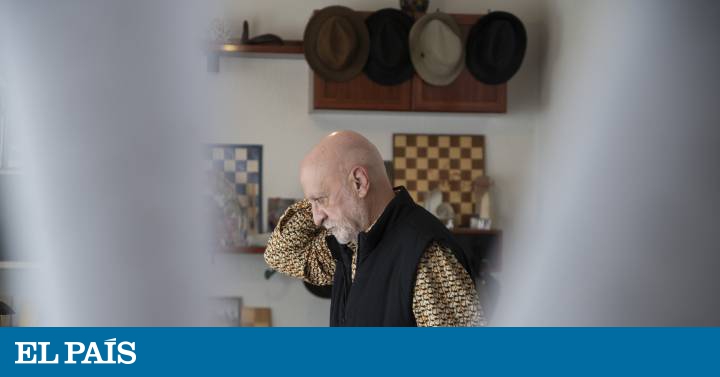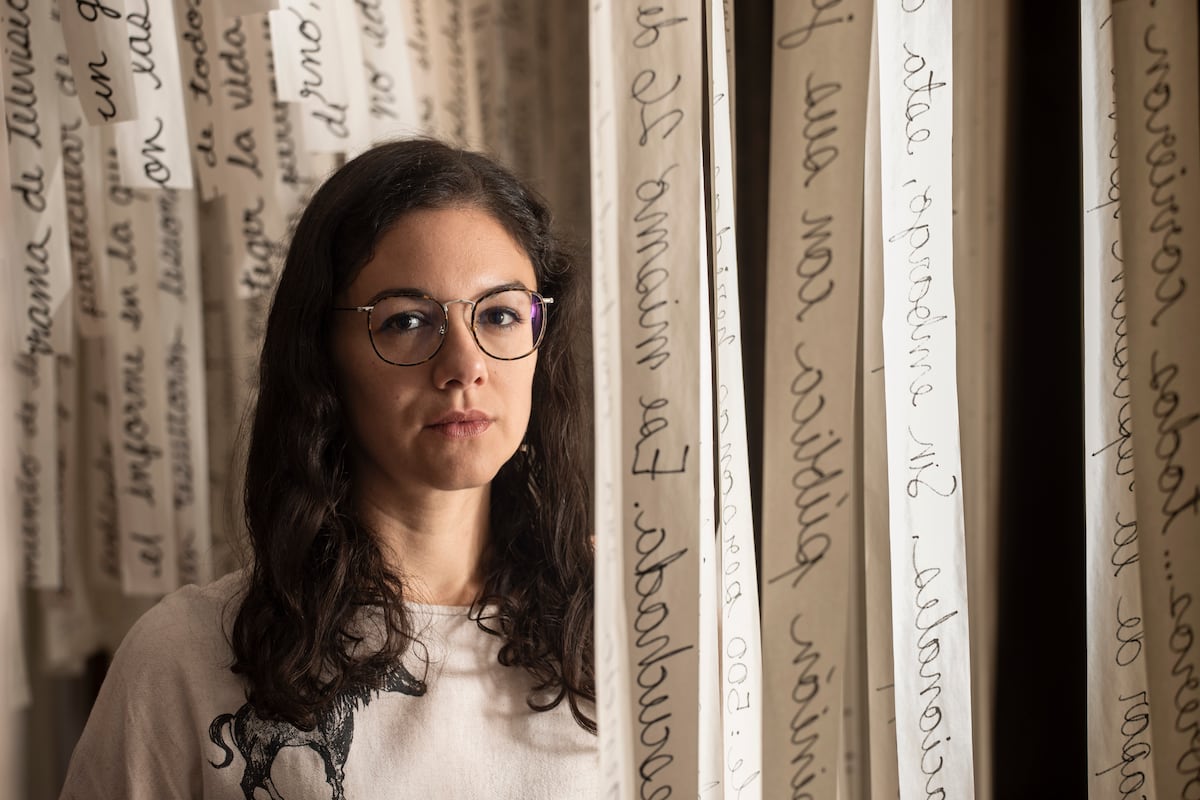Eduardo Scala's house —a rented apartment in Ávila outside the city that he calls “base camp” —is a motley map of his life.
From the walls of the room that serves as his study hang many of his projects arranged in plastic covers: from "visual poems for the blind" to a mural in Mexico City, passing through a magazine in which the Queen is seen in Palma de Mallorca.
The caption reads: “Doña Letizia wore a
very informal
look
composed of white trousers and a black T-shirt, designed by the poet and artist from Madrid Eduardo Scala for the Delirio publishing house, where you could read the word
Kafka
.
It costs 15 euros ”.
The print on that T-shirt is one of the portraits of writers, scientists and thinkers that Scala executes in the form of calligrams - "biograms", he says - since in 1978 the method "appeared" to him working with the letters of "Alfonso X the wise".
That same system is the one used in the 16 portraits of artists —Paul Klee, Remedios Varo, Maruja Mallo, Mondrian— for the show that can be seen at the Guillermo de Osma gallery in Madrid.
The exhibition also coincides with the publication of
Re / tratos
(Books of Resistance), a compilation of alphabetic constellations, palindromes and space games arising from a highly personal mix of linguistics, kabbalah and mathematics.
MORE INFORMATION
PHOTO GALLERY The universe of Eduardo Scala
The 75-year-old "poet and artist from Madrid" believes that Doña Letizia bought the shirt at the 2015 Book Fair, but does not remember it.
He is more interested in chess queens.
Another of the walls of his study is full of boards and Scala admits that he would not have arrived at poetry or art if he had not been a chess player before.
He stopped competing at the age of 22, after becoming Madrid youth champion.
"It was my language," he says.
“The world of chess has a truth that the world of art does not.
There are no false prestige.
When they tell you that someone is very good, you reply: 'Let's see how he plays.'
It is the gymnastics of the brain.
The first thing I do every morning is play a quick game on the Internet to see how my head is doing.
It puts me to work ”.
He left it because he was “more an artist than a sportsman”: “We were going to a tournament in Italy in a 600, the Germans went to bed at nine at night to be fresh the next morning and I was still walking at two walking along the beach ”.
enlarge photo Eduardo Scala's project on the wall of his house in Ávila.
Inma Flores
When he left the competition, he dedicated himself to teaching chess in Malaga and Mallorca - "that's what I've lived through" - and writing about great games.
In 1992 he covered Bobby Fischer's reunion with Boris Spassky in Belgrade blocked by the Balkan war.
Three years later he traveled to the world championship that Gary Kasparov and Viswanathan Anand played on the observatory - floor 107 - of the World Trade Center in New York.
“Fischer was absolute precision, a madman, an esthete.
I treated him remotely ”.
For Kasparov he designed the cover of the five volumes of
My Great Predecessors
, his particular story of the great masters.
Anand, who lost, seemed to him "very humble, an anti-hero."
"The Americans turned that into a fairground barracks," he recalls, "but it is impressive to think that the first game was played on September 11, 1995 and that the Twin Towers no longer exist."
Scala traveled to Manhattan accompanied by photographer Carlos Tarancón.
They came back with 100 snapshots of all the "micromanages" from the players.
They were never published.
The magazine that had sent them,
El Europeo
, closed before they saw the light.
Now they want to recover that material in an exhibition and a book.
Another milestone in Eduardo Scala's sports career was the game he played in 1991 with John Cage.
It appears in his biographical notes, but he downgrades the literature: “I was in Madrid and they introduced him to me.
He had a special aura.
He had come to chess through Duchamp — a true master — but he was no good.
I went through a critical moment: I realized that I was playing with a saint, with an innocent.
I offered him a draw and we left him ”.
enlarge photo 'Re / deal with Vasili Kandinski' (2020), by Eduardo Scala.
Courtesy Guillermo de Osma Gallery
When Eduardo Scala left chess, he began to write verses that he describes as “strong, blasphemous, beat, countercultural”.
Then add another qualifier: "Garbage."
Overcoming shame, he takes out a 1971 issue of the magazine
Poesía Hispánica
, directed by José García Nieto, and opens it with a 'Triptych to Pavese' that bears his signature.
“They didn't know me, but they published me.
If you go with passion ahead, they applaud you.
Passionate bad things like a lot.
Poetry is another matter.
That was a position: you want to be a writer and you put yourself on it ”.
That same year he burned all his writings to arrive, in 1974, at his first adult work:
Geometría del ectasis
.
It was followed by titles such as
SO
L
UNA
—based on the union of opposites— or
Ars de Job
, a monosyllabic book that, along with six others, brought together in a volume published by Siruela.
It is your
Canticle of Unity.
At the same time, he began working on projects described with labels that he drastically rejects even though they have secured him a place in the history of literature and art (section: unclassifiable).
Visual poetry?
“From the first clay tablet, all writing is visual.
Once a blind actress performed my poems.
What is that?".
Artist book?
“Demeaning ridiculousness.
A manuscript is a manuscript ”.
Experimental poetry?
“Research with the alphabet does not begin in the avant-garde, it has centuries.
I erase all my experimentation.
I don't keep those documents that museums now like.
In any case, it would be spiritual ", he adds, citing Cervantes' mixture between spirit and experience:" I am not interested in games of wit.
I try to get closer to the mystery that each word contains.
To the sacred.
Poetry is a support for meditation ”.
That is what has led him to study Kabbalah, Buddhism, Christian mysticism, and Sufi.
Also what brought him to Ávila, “a city without temptations” to which he arrived eight years ago after losing “families and libraries” along the way.
He rented a room and shared a flat with two passing teachers.
When they left, he took over the entire rent, giving up "the superfluous."
"Eight years in Ávila without heating!", He says, wrapped in several layers of clothing, including a hat, while he bustles through the "camp".
"It is not a heroic act, I am annoyed by those who are heroes.
I am divinely.
There is silence, I work on my things, go for a walk, I go to the mystical studies center.
It is always sunny in Ávila, even if it snows ”.
Beyond chess classes, he has never wanted a "job job."
Years ago he spent six months in a printing company and that's where it all ended: “If you are responsible, you do things well.
Outcome?
They wanted to raise my salary.
I took off.
It is selling your energy, your life.
If you're going to have a crisis, it better be yours, not the angry boss.
If there are problems, they better be real.
Sometimes you reach extreme situations, of necessity.
But you have to gamble, it's your game ”.
The word painter. Re / treatments of artists.
Eduardo Scala.
Guillermo de Osma Gallery.
Madrid.
Until November 13.
Pictures. Keys.
Eduardo Scala.
Books of the Resistance, 2020. 238 pages.
15 euros.




/cloudfront-eu-central-1.images.arcpublishing.com/prisa/TGZ4TIGSGJFWBISZ2FULJ7BYDQ.jpg)

/cloudfront-eu-central-1.images.arcpublishing.com/prisa/F5VANCBUYFB3LMPKZA6B23DBJA.jpg)

/cloudfront-eu-central-1.images.arcpublishing.com/prisa/GOC4OMOSPRGHBC3AGTSKUSEWDY.jpg)






